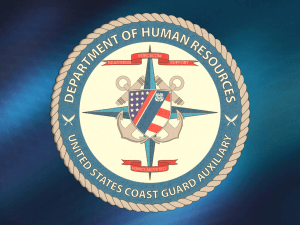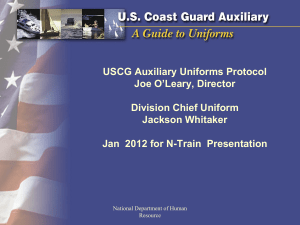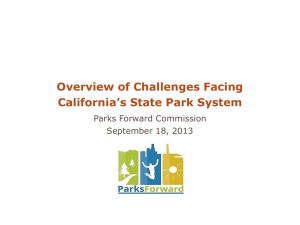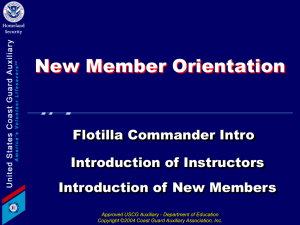pe/bss/10 powering your boat Augmented
advertisement
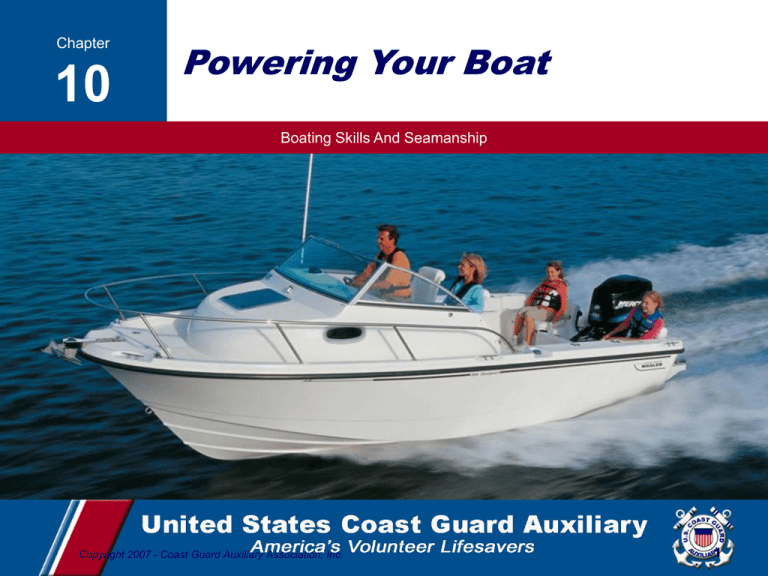
Chapter 10 Powering Your Boat Boating Skills And Seamanship Copyright 2007 - Coast Guard Auxiliary Association, Inc. 1 Lesson Objectives Boating Skills And Seamanship • Types and characteristics of marine engines • Two and four stroke engines • Operation and care • Gasoline selection • Battery maintenance Copyright 2007 - Coast Guard Auxiliary Association, Inc. 2 Lesson Objectives (2) Boating Skills And Seamanship • • • • Electrical system Galvanic action Winterizing and commissioning Trouble shooting Copyright 2007 - Coast Guard Auxiliary Association, Inc. 3 Types of Marine Engines (Roger’s slide for clarity) Boating Skills And Seamanship • Installation location • Inboard • Outboard • Operating cycle • 2 cycle • 4 cycle • Fuel type • Gas • Diesel Copyright 2007 - Coast Guard Auxiliary Association, Inc. 4 Types of Marine Propulsion (Roger’s slide for clarity) Boating Skills And Seamanship • Outboard: Unit containing engine, shafts, prop located outside & attached to transom • Inboard: Engine in boat, shaft through hull, external prop & rudder, prop at angle to water surface, no trim function • • • Traditional uses straight shaft, engine is well forward of transom Tunnel drive V drive moves engine to transom, shaft cut into two and leaves engine going forward, then reverses • Inboard/Outboard (I/O): Engine inboard at stern, external drive includes prop parallel to water surface, driven by shafts at 90 degrees. Swivel drive to turn; no rudder • • Traditional I/O has large transom cut out Tractor or 360 degree swivel, shaft through hull, drive & prop under hull • Jet drive: Impeller no prop, pumps water for thrust. Swivel nozzle to turn. Copyright 2007 - Coast Guard Auxiliary Association, Inc. 5 Types of Marine Engines Boating Skills And Seamanship • Installation (these are propulsion, not engine) Inboard Inboard/outboard (stern drive) Copyright 2007 - Coast Guard Auxiliary Association, Inc. Outboard 6 Types of Marine Engines Boating Skills And Seamanship Intake Exhaust Intake Exhaust Intake Port • Operating Cycle Exhaust Port • Who can recall some of the differences 2 1 2 Four-Stroke in the two-stroke and Two-Stroke four-stroke Intake Exhaust Intake Exhaust engines? 1 3 4 Copyright 2007 - Coast Guard Auxiliary Association, Inc. 3 4 5 7 Types of Marine Engines Boating Skills And Seamanship • Types of fuel used • What are the advantages and disadvantages in engines fueled by diesel rather than gasoline? Copyright 2007 - Coast Guard Auxiliary Association, Inc. 8 Types of Marine Engines Boating Skills And Seamanship • Risks from fuel • Gasoline • Diesel Copyright 2007 - Coast Guard Auxiliary Association, Inc. 9 Types of Marine Propulsion Boating Skills And Seamanship • Inboard engines • Engine in boat, shaft through hull, external prop & rudder, prop at angle to water surface Direct - Drive V - Drive Reprinted with permission from Boatowner’s Mechanical and Electrical Manual, Third Edition, by Nigel Calder Copyright 2007 - Coast Guard Auxiliary Association, Inc. 10 Types of Marine Propulsion Boating Skills And Seamanship • Jet drives • Power • Steering Copyright 2007 - Coast Guard Auxiliary Association, Inc. 11 Types of Marine Propulsion Boating Skills And Seamanship • Tunnel drives Copyright 2007 - Coast Guard Auxiliary Association, Inc. 12 Types of Marine Propulsion Boating Skills And Seamanship • Stern drive • Engine inboard at stern, external drive includes prop parallel to water surface, driven by shafts at 90 degrees. Swivel drive to turn; no rudder • What are advantages and disadvantages of the stern-drive engine? Copyright 2007 - Coast Guard Auxiliary Association, Inc. 13 Types of Marine Propulsion Boating Skills And Seamanship • Outboard engine • Unit containing engine, shafts, prop located outside & attached to transom Copyright 2007 - Coast Guard Auxiliary Association, Inc. 14 Induction Systems Boating Skills And Seamanship • Carburetor • Fuel is mixed with air, then passed into the cylinder • Backfire may cause flame to come out air intake. Use flame arrester. • Fuel injection • Fuel injected into cylinder to mix with air • Some use flame arrester • Diesel injects once cylinder is compressed, triggering ignition Copyright 2007 - Coast Guard Auxiliary Association, Inc. 15 Ignition Systems Boating Skills And Seamanship • Diesel • Heat of compression • Gasoline • Spark from plugs • Magneto ignition • Ignition breaker point system • Electronic Copyright 2007 - Coast Guard Auxiliary Association, Inc. 16 Cooling Systems Boating Skills And Seamanship • Air cooled • Water cooled • Open System Pumps Sea Water Through Engine • Closed or dual system • Sea Water Pumped Through Heat Exchanger • Fresh Water with Antifreeze Pumped Through Engine & Heat Exchanger • Telltale on outboards Copyright 2007 - Coast Guard Auxiliary Association, Inc. 17 Gasoline Considerations Boating Skills And Seamanship • Octane • Reformulated • Fuel tanks • Fuel stability • Condensation • Filter Copyright 2007 - Coast Guard Auxiliary Association, Inc. 18 Batteries Boating Skills And Seamanship • Charged • Switch • Running on both = same as one battery • Secure Copyright 2007 - Coast Guard Auxiliary Association, Inc. 19 Maintenance Boating Skills And Seamanship • • • • • • Lubrication Crankcase Bilge pumps Belts Ignition system Zincs Reprinted with permission from Outboard Engines by Edwin R. Sherman Copyright 2007 - Coast Guard Auxiliary Association, Inc. 20 Winterizing Your Boat Boating Skills And Seamanship • • • • • • • • • Crankcase Transmission Fuel tank Gasoline engine Cooling systems Lower units Ignition system Freshwater system Heads Copyright 2007 - Coast Guard Auxiliary Association, Inc. 21 Spring Fitting Out Boating Skills And Seamanship • Out of the water • In the water Copyright 2007 - Coast Guard Auxiliary Association, Inc. 22 Trouble Shooting Boating Skills And Seamanship • • • • Engine won’t turn over Engine won’t start Engine runs rough Engine idles but does not develop full power Copyright 2007 - Coast Guard Auxiliary Association, Inc. 23
